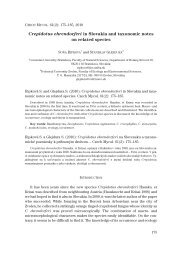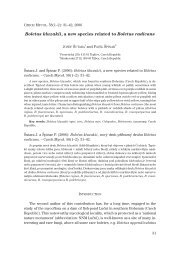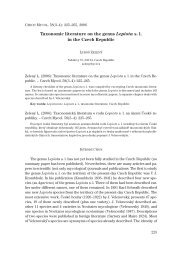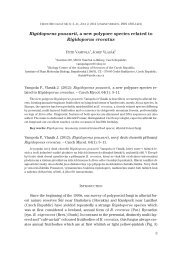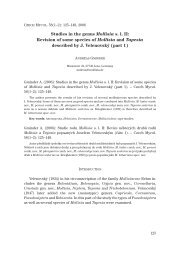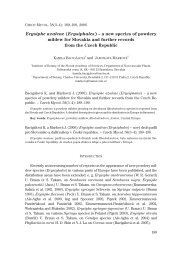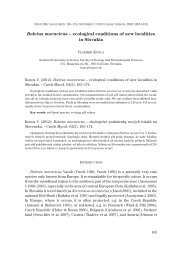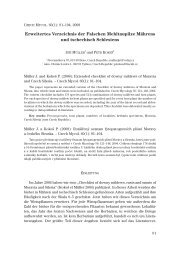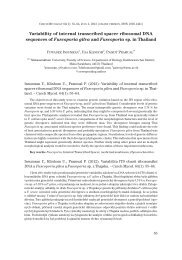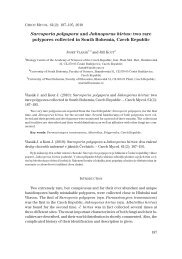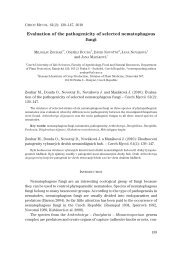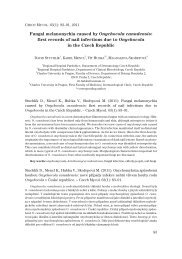Contribution to a monograph of marasmioid and collybioid fungi in ...
Contribution to a monograph of marasmioid and collybioid fungi in ...
Contribution to a monograph of marasmioid and collybioid fungi in ...
Create successful ePaper yourself
Turn your PDF publications into a flip-book with our unique Google optimized e-Paper software.
NOORDELOOS M. E. AND ANTONÍN V.: MARASMIOID AND COLLYBIOID FUNGI IN EUROPEFig. 1. Marasmiellus corsicus. Pileipellis (PP), basidium, cheilocystidia (CH), spores, caulocystidia(CA). Bar = 10 μm. All figures from holotype.23
CZECH MYCOL. 60(1): 21–27, 2008C o l l e c t i o n e x a m i n e d. France, Corsica, Porticcio, 4 Nov. 2000, P.-A.Moreau 00110414 (L).Notes. Marasmiellus corsicus is dist<strong>in</strong>guished by its relatively pale pileuswith very f<strong>in</strong>e brownish squamules <strong>and</strong> densely pru<strong>in</strong>ose, pale brown stipe, whichis not significantly darker coloured <strong>to</strong>wards base. Microscopically the long, narrowspores rem<strong>in</strong>d those <strong>of</strong> M. ramealis var. macrosporus (Courtec.) An<strong>to</strong>nín &Noordel., which differs by hav<strong>in</strong>g a more pronounced Ramealis-structure <strong>in</strong> thepileipellis, coralloid caulocystidia, <strong>and</strong> 2-spored basidia. Marasmiellus maasgeesteraniRobich & Campo is also similar, but differs by hav<strong>in</strong>g darker colouredbasidiocarps, much broader spores [(9–)10–12(–13.5) × 5–6.5(–7.5) μm], less dist<strong>in</strong>ctlydiverticulate pileipellis hyphae, <strong>and</strong> differently shaped cheilocystidia.NEW NAMES AND NEW COMBINATIONSGymnopus bisporiger An<strong>to</strong>nín & Noordel., nom. nov.(MycoBank MB511578)Marasmiellus bisporigerus Noordel. & Uljé <strong>in</strong> An<strong>to</strong>nín & Noordeloos, Libri botanici 17: 179. 1997,non Marasmiellus bisporiger S<strong>in</strong>ger, Nova Hedwigia, Beih. 44: 324. 1973. – Micromphale bisporigerumNoordel., Persoonia 13: 258. 1987 (nom. prov.).N o t e s. When describ<strong>in</strong>g Marasmiellus bisporigerus, Noordeloos & Uljé un<strong>in</strong>tentionallycreated an illegitimate homonym <strong>of</strong> Marasmiellus bisporiger S<strong>in</strong>ger1973. By propos<strong>in</strong>g the new name Gymnopus bisporiger, the present authors correctthis unfortunate mistake. For detailed macroscopic <strong>and</strong> microscopic descriptions<strong>and</strong> draw<strong>in</strong>gs <strong>of</strong> microscopic characters, see Noordeloos (1987, as Micromphalebisporigerum), <strong>and</strong> An<strong>to</strong>nín <strong>and</strong> Noordeloos (1997, as Marasmiellusbisporigerus).The gelat<strong>in</strong>ised pileipellis with nodulose hyphae make this taxon a good species<strong>of</strong> Gymnopus sect. Gloeonemae. It is dist<strong>in</strong>guished from Gymnopus foetidus(Sowerby: Fr.) J. L. Matta & R. H. Petersen <strong>and</strong> G. perforans (H<strong>of</strong>fm.: Fr.) An<strong>to</strong>nín& Noordel. by its t<strong>in</strong>y basidiocarps, 2-spored basidia, <strong>and</strong> clampless hyphae.Marasmiellus maritimus Contu & Noordel., nom. nov.(MycoBank MB511690)Marasmiellus roseot<strong>in</strong>ctus Contu & Noordel., Österr. Z. Pilzk. 16: 181. 2007, non Marasmiellusroseot<strong>in</strong>ctus Pegler, Persoonia 4: 111. 1966.N o t e s. Describ<strong>in</strong>g their taxon, Contu <strong>and</strong> Noordeloos (2007) omitted the existence<strong>of</strong> the species Marasmiellus roseot<strong>in</strong>ctus described by Pegler (1966) fromUg<strong>and</strong>a. Therefore, the necessary new name for the European species is proposedhere.24
NOORDELOOS M. E. AND ANTONÍN V.: MARASMIOID AND COLLYBIOID FUNGI IN EUROPEGymnopus sect. Androsacei (Kühner) An<strong>to</strong>nín & Noordel., comb. nov.(MycoBank MB511559)Basionym.Marasmius sect. Androsacei Kühner, Botaniste 25: 91. 1933. (as 'Androsaceae').N o t e s. This proposed new comb<strong>in</strong>ation, as well as the follow<strong>in</strong>g two, arebased on the results <strong>of</strong> studies e. g. by Mata et al. (2004), Matheny et al. (2006) <strong>and</strong>Wilson <strong>and</strong> Desjard<strong>in</strong> (2005). These studies showed that the type species <strong>of</strong>Marasmius sect. Androsacei Kühner (= Setulipes An<strong>to</strong>nín 1987) <strong>and</strong> MicromphaleGrey 1821 belong <strong>to</strong> the /gymnopus clade.Gymnopus quercophilus (Pouzar) An<strong>to</strong>nín & Noordel., comb. nov.(MycoBank MB511564)Basionym.Marasmius quercophilus Pouzar, Česká Mykol. 36: 1. 1982.Gymnopus perforans (H<strong>of</strong>fm.: Fr.) An<strong>to</strong>nín & Noordel., comb. nov.(MycoBank MB511562)Basionym.Agaricus perforans H<strong>of</strong>fm., Nomencl. Fung. 1: 215, pl. 4, fig. 2. 1789.The follow<strong>in</strong>g three species belong <strong>to</strong> the clade /gymnopus (for references seeabove), hence necessary comb<strong>in</strong>ations are proposed.Gymnopus potassiovirescens (Contu) An<strong>to</strong>nín & Noordel., comb. nov.(MycoBank MB511560)Basionym.Collybia potassiovirescens Contu, Boll. Gruppo Micol. Bres. 43(1): 4. 2000.Gymnopus pyrenaeicus (Bon & Ballara) An<strong>to</strong>nín & Noordel., comb. nov.(MycoBank MB511561)Basionym.Collybia pyrenaeica Bon & Ballara, Bull. Trim. Féd. Mycol. Dauph<strong>in</strong>é-Savoie 147: 10. 1997.Gymnopus vernus (Ryman) An<strong>to</strong>nín & Noordel., comb. nov.(MycoBank MB511565)Basionym.Collybia verna Ryman, Bot. Notiser 131: 197. 1978.N o t e s. In the first edition <strong>of</strong> our <strong>monograph</strong> (An<strong>to</strong>nín <strong>and</strong> Noordeloos 1997),this species was mentioned as Gymnopus nivalis (Luthi & Plomb) An<strong>to</strong>nín &Noordel. However, this comb<strong>in</strong>ation is based on <strong>in</strong>valid basionym as Luthi <strong>and</strong>Plomb (1967) did not mention the holotype specimen <strong>in</strong> their description <strong>of</strong>Marasmius nivalis.Moreau (1998) showed that Collybia verna Ryman is identical with M. nivalis.The formal comb<strong>in</strong>ation <strong>in</strong> the genus Gymnopus is proposed here.25
CZECH MYCOL. 60(1): 21–27, 2008The studies by Mata et al. (2004) <strong>and</strong> Wilson <strong>and</strong> Desjard<strong>in</strong> (2005) showed thatspecies <strong>of</strong> Marasmius sect. Chordales Fr. are monophyletic with<strong>in</strong> /omphalotaceae.Wilson <strong>and</strong> Desjard<strong>in</strong> (2005) accepted the generic name Mycet<strong>in</strong>is Earlefor it, <strong>and</strong> already made some comb<strong>in</strong>ations. The necessary new comb<strong>in</strong>ations forEuropean taxa are proposed here.Mycet<strong>in</strong>is scorodonius var. virgul<strong>to</strong>rum (Malençon & Bertault) An<strong>to</strong>nín &Noordel., comb. nov.(MycoBank MB511566)Basionym. Marasmius scorodonius var. virgul<strong>to</strong>rum Malençon & Bertault, Trav. Inst. Sci.Cherifien, Ser. Bot. 33: 382. 1975.Mycet<strong>in</strong>is querceus (Britzelm.) An<strong>to</strong>nín & Noordel., comb. nov.(MycoBank MB511567)Basionym.Marasmius querceus Britzelm., Bot. Centralbl. 68: 7. 1896.Mycet<strong>in</strong>is epidryas (Kühner) An<strong>to</strong>nín & Noordel., comb. nov.(MycoBank MB511568)Basionym.Marasmius epidryas Kühner, Ann. Soc. L<strong>in</strong>n. Lyon 79(“1935”): 115. 1936.Mycet<strong>in</strong>is kallioneus (Huht<strong>in</strong>en) An<strong>to</strong>nín & Noordel., comb. nov.(MycoBank MB511569)Basionym.Marasmius kallioneus Huht<strong>in</strong>en, Mycol. Helvetica 1: 342. 1985.ACKNOWLEDGEMENTSResearch by the second author was supported by the M<strong>in</strong>istry <strong>of</strong> Culture <strong>of</strong> theCzech Republic (MK00009486201).REFERENCESANTONÍN V. <strong>and</strong> NOORDELOOS M. E. (1993): A <strong>monograph</strong> <strong>of</strong> Marasmius, Collybia <strong>and</strong> related genera <strong>in</strong>Europe. Part 1: Marasmius, Setulipes, <strong>and</strong> Marasmiellus. – In: Libri Botanici 8: 1–229, Ech<strong>in</strong>g.ANTONÍN V. <strong>and</strong> NOORDELOOS M. E. (1997): A <strong>monograph</strong> <strong>of</strong> Marasmius, Collybia <strong>and</strong> related genera <strong>in</strong>Europe. Part 2: Collybia, Gymnopus, Rhodocollybia, Cr<strong>in</strong>ipellis, Chae<strong>to</strong>calathus, <strong>and</strong> additions<strong>to</strong> Marasmiellus. – In: Libri Botanici 17: 1–256, Ech<strong>in</strong>g.ANTONÍN V. <strong>and</strong> NOORDELOOS M. E. (2008): A <strong>monograph</strong> <strong>of</strong> <strong>marasmioid</strong> <strong>and</strong> <strong>collybioid</strong> <strong>fungi</strong> <strong>in</strong> Europe.– Ech<strong>in</strong>g (<strong>in</strong> press).LUTHI R. <strong>and</strong> PLOMB G. (1967): Un marasme nouveau: Marasmius nivalis nov. sp. – Bull. Soc. Mycol.Fr. 83: 739–742.26
NOORDELOOS M. E. AND ANTONÍN V.: MARASMIOID AND COLLYBIOID FUNGI IN EUROPEMATA J. L., HALLING R. E. <strong>and</strong> PETERSEN R. H. (2004): New species <strong>and</strong> mat<strong>in</strong>g system reports <strong>in</strong>Gymnopus (Agaricales) from Costa Rica. – Fungal Diversity 16: 113–129.MATHENY P. B., CURTIS J. M., HOFSTETTER V., AIME C., MONCALVO J.-M., GE Z.-W., SLOT J. C., AMMIRATI J. F.,BARONI T. J., BOUGHER N. K., HUGHES K. W., LODGE J., KERRIGAN R. W., SEIDL M. T., AANEN D. K.,DENITIS M., DANIELE G. M., DESJARDIN D. E., KROPP B. R., NORVELL L. L., PARKER A., VELLINGA E. C.,VILGALYS R. <strong>and</strong> HIBBETT D. S. (2006): Major clades <strong>of</strong> Agaricales: a multilocus phylogenetic overview.– Mycologia 98(6): 982–995.MONCALVO J.-M., VILGALYS R., REDHEAD S. A., JOHNSON J. E., JAMES T. Y., AIME C., HOFSTETTER V.,VERDUIN S. J. W., LARSSON E., BARONI T. J., THORN R. G., JACOBSSON S., CLÉMENÇON H. <strong>and</strong> MILLERO. K. JR. (2002): One hundred <strong>and</strong> seventeen clades <strong>of</strong> euagarics. – Molecular Phylogenetics Evol.23: 357–400.MOREAU P.-A. (1998): Note taxonomique et nomenclaturale sur Collybia verna Ryman. – Bull. Soc.Mycol. Fr. 114(2): 11–18.NOORDELOOS M. E. (1987): Notulae ad floram agaric<strong>in</strong>am neerl<strong>and</strong>icam XV. Marasmius, Marasmiellus,Micromphale, <strong>and</strong> Hohenbuehelia. – Persoonia 13: 237–262.NOORDELOOS M. E. <strong>and</strong> CONTU M. (2007): On two remarkable Marasmiellus species from Sard<strong>in</strong>ia,Italy. – Öster. Z. Pilzk. 16: 181–186.OWINGS P. <strong>and</strong> DESJARDIN D. E. (1997): A molecular phylogeny <strong>of</strong> Marasmius <strong>and</strong> selected segregategenera. – Inoculum 48(3): 29.PEGLER D. N. (1966): Tropical African Agaricales. – Persoonia 4(2): 73–124.SINGER R. (1973): The genera Marasmiellus, Crepidotus <strong>and</strong> Simocybe <strong>in</strong> the Neotropics. – NovaHedwigia, Beih. 44: 1–339.WILSON A. W. <strong>and</strong> DESJARDIN D. E. (2005): Phylogenetic relationships <strong>in</strong> the gymnopoid <strong>and</strong> <strong>marasmioid</strong><strong>fungi</strong> (Basidiomycetes, euagaric clade). – Mycologia 97(3): 667–679.27



